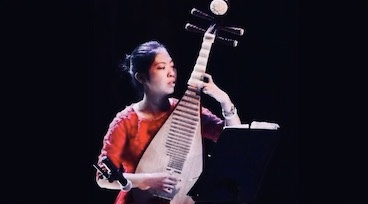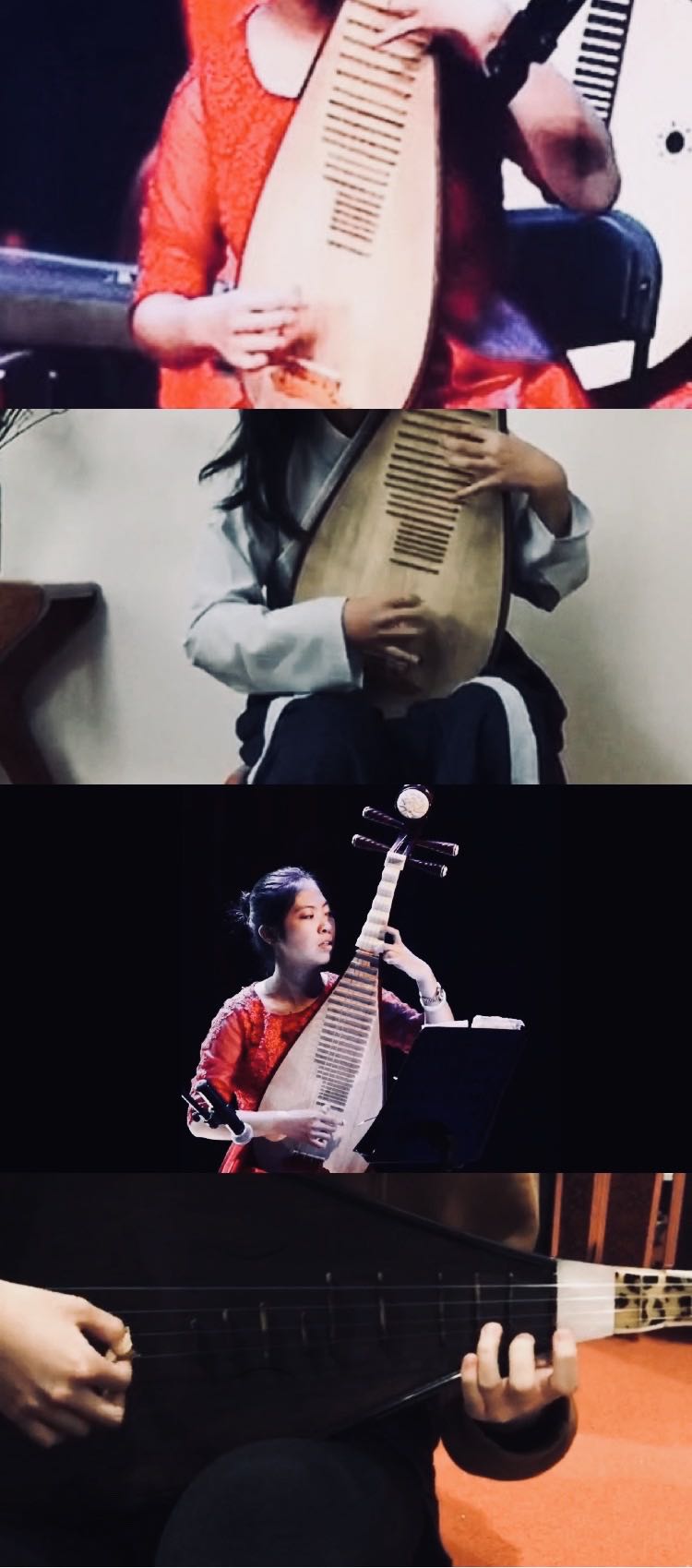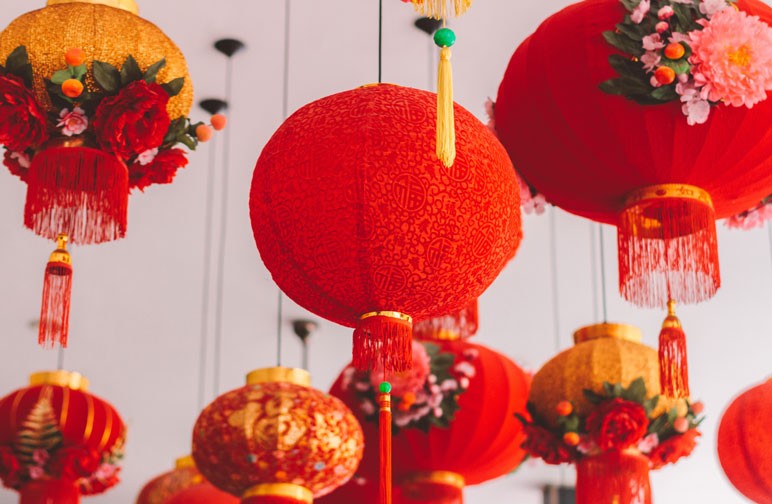The Girl with the Pipa

The pipa has been a part of my life for more than ten years. There were many days and nights when I had to sit in the practice room, drilling the boring basic skills. When I was a child, my pipa teacher was very strict. She was always holding a shaft in her hand and she would smack my hand when I played incorrectly or poorly. Although it did hurt much physically, it was really an embarrassing punishment. Since the second grade of primary school, I have spent at least four hours every weekend to rehearse for the orchestra in the rehearsal hall, plus at least two hours of practice every single day. I think I have spent more than 10,000 hours on the pipa. By the 10,000-hour rule, I must have achieved excellence in playing this instrument! My teacher once said, "If you interrupt one day's practice, only you can tell; if you interrupt two days of practice, your teachers and professionals will know; but if you stop three days of practice, every one in the audience will know.” This experience also reminds me that persistence is the most important factor in determining success or failure. If you persist, you might succeed; if you give up, you are sure to fail. Although it was my parents who signed me up for my first pipa class, I have truly built a connection with the instrument. But what is this magical instrument?

Caption: Snapshots of myself playing the pipa
Music of the South
There is a special type of Chinese folk music called Nanyin which literally means “music of the south”. Basically, Nanyin is a type of Chinese folk music that needs to sing while playing the instrument, Nanyin originated in Quanzhou, Fujian, southern China. In general, Nanyin is sung in Hokkien, a dialect that Fujian people speak. In Nanyin performance, while singing, players also need to play instruments to bring background music. But it is also possible if you just play te instrument but do not sing. Because not everyone knows how to speak Hokkien, playing the instruments alone is easier. Nanyin has a very long history. It is the oldest existing ancient Han music in China, and it is also listed among the world intangible cultural heritages. Since the Han Dynasty, people from the Central Plains migrated to Quanzhou and combined their own kinds of traditional music with Quanzhou’s folk music, conjugate a cultural manifestation with the ancient music of the central Plains. Some Nanyin instruments share similarities with instruments from the Central Plains. That was the beginning of Nanyin.
Please click here to see the video.
The Pipa and Its Sister
The pipa, sometimes called the Chinese lute, is known as the "king of plucked instrument". You may wonder why the seemingly simple string instrument deserves to be the “king”. That's because it can imitate many pieces of music perfectly. So with pipa, you have a whole orchestra. The pipa dates back to the Qin Dynasty, but in the Northern Southern Dynasties, an instrument which is similar to pipa was introduced from the Western Regions. People combined their characteristics and pipa changed from being held horizontally when playing to a vertical position. Now, of course, there are other types of pipa that are held horizontally, such as the Nanyin pipa. However, the pipa is better known than Nanyin pipa, and it is more difficult to master the pipa playing skills. For example, from my own experience, it would be much easier to learn Nanyin pipa after learning the pipa. Let me tell you a little bit more about the pipa. Its body is shaped like a pear, which helps to produce a more rounded tone. It can have four or five strings, and a five-string pipa is very rare now. The pipa has a very wide range of sounds, so it can play almost anything if the player finds the right fingering. Their biggest weakness is that the strings are easily loosened. For the players, it is really horrifying if the strings become loose during the performance!
The Nanyin pipa has a longer history than the pipa. Since the Han Dynasty, people from the Central Plains migrated to Quanzhou and combined their own kind of traditional music with Quanzhou’s folk music, conjugating a cultural manifestation with the ancient music of the Central Plains. That was the beginning of Nanyin, as well as the beginning of Nanyin pipa. If you have a chance to visit Quanzhou, you will find that almost all the men, women and children there can play Nanyin pipa. You can even enjoy a performance in a roadside teahouse, or go up to show your skills. You will surely get a good round of applause and a cup of four-fruit soup that the boss of the teahouse treats you to. Although Nanyin pipa can't play so many styles of music, it can play the most authentic and irreplaceable Southern notes. And the instrument plays the most important position in the Nanyin orchestra, guiding the progress of the whole tune.
Please click here to see the video.
The Ancient Chinese music notation
Gongche notation (or gongchepu) is a traditional Chinese musical notation method. It got its name from the Tang Dynasty in China because of its characters such as labor and ruler. In traditional writing, the scale is straight from right to left, like text, but it can now be written in horizontal rows. Generally, the Chinese characters 合、四、一、上、尺、工、凡、六、五、乙, etc., are used as the basic symbols for pitch, which are the equivalents of sol, la, ti, do, re, mi, fa, sol, la, ti. Homophonic name high octave, you can pick up the end of the spectrum, or add side 亻, for example, 仩 is one octave higher than 上. Homophonic name is low octave, so the representation is that the last stroke of the spectrum word should be low down. The rhythmic symbol of Gongche notation is called eye and plate. The board represents the downbeat, the eye represents the downbeat. However, the use of Gongche notation is now quite rare, most instruments use the octave notation, such as the pipa. But there are many more orthodox ancient instruments that still use Gongche notation, such as the Nanyin pipa.
A Further Look
In August 2019, I went to Quanzhou to learn the most orthodox Nanyin music. I had a tutor at the time, and our first “mission” was to find the local Nanyin band. We went to a small park, a teahouse, and a professional theater. It has to be said that different environments breed different feelings of music. In my observation, the Nanyin music in the park is relatively casual, with older players and more traditional repertoire. The players in the teahouse pay more attention to the audience's preferences and prefer to perform some tunes that most people are familiar with. The repertoire is more complex, and the people who actually go into the theatre to see the performance are relatively professional, so the atmosphere is more artistic. The differences in performance styles and characteristics brought by different occasions prove that Nanyin has strong adaptability and is very popular in Quanzhou.
In order to study the reasons why Nanyin has been passed down for thousands of years and remains popular, we conducted a street interview in our spare time. In order to ensure the diversity of research subjects, I paid attention to the following points when selecting research subjects: the diversity of age and the diversity of interview locations. In terms of age, I roughly divided the respondents into the following four groups: minors, young people aged 18-30, middle-aged people aged 30-55, and retirees aged over 55. In terms of interview locations, I chose professional theaters, bustling commercial centers, parks, teahouses, and schools. The total number of interviews was limited to 20, and four people of different ages were interviewed at each site. My questions are as follows:
1. Do you know what Nanyin is?
2. Have you and your family ever studied Nanyin?
3. What role do you think Nanyin plays in your life?
4. How much do you know about the history of Nanyin?
5. What do you think is the reason that Nanyin has been immortal for thousands of years?
After I finished the interview, I summed up all interview material, and it was quite a shock that almost all the local people of all ages can sing a few Nanyin tunes or play Nanyin instruments. This stems from the childhood environment in Quanzhou. One little girl said that her grandfather would play Nanyin at home every day, and sometimes invited his friends to play in unison. Unconsciously, Nanyin has become an indispensable part of her life. Besides family factors, social factors are also very important. There are many teahouses along the street, and Nanyin plays from morning till night every day. Sometimes families take their children to the theater to enjoy Nanyin. I once wondered what makes the love for Nanyin exist in their blood, but my tutor told me, “when something becomes a habit and you can't live without it, then it is part of your lifestyle, not just a hobby.”
About the author:
Zhang Ke is now attending Grade 12 at The Affiliated High School of Peking University.
Get the weekly newsletter!
Sign up to get the entertainment, lifestyle and event news from Urban Family every week!Classified Posts
Guide





















